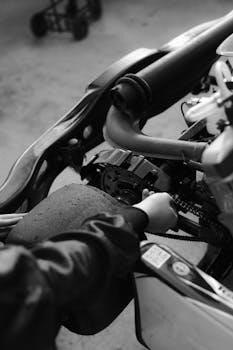Manual primary chain tensioners are aftermarket components designed to replace the stock automatic tensioners found in Harley-Davidson Twin Cam engines. They offer a more direct, adjustable approach to maintaining chain tension, which can be preferred by some riders.
What is a Primary Chain Tensioner?
A primary chain tensioner is a critical component within a motorcycle’s primary drive system. Its main function is to maintain the correct tension on the primary chain, which transmits power from the engine’s crankshaft to the clutch and transmission. In Harley-Davidson Twin Cam engines, the tensioner ensures smooth power delivery and prevents excessive chain slack or tightness. This is vital for efficient performance and the longevity of the primary components, such as the chain, sprockets, and bearings. Without a properly functioning tensioner, the chain could wear out prematurely, cause excessive vibration, or even lead to component failure. It is an essential part for proper function.
Automatic vs. Manual Tensioners⁚ A Comparison
Automatic tensioners, often found as stock equipment, use a spring-loaded mechanism or hydraulic pressure to maintain chain tension. They self-adjust as the chain stretches, which is convenient but can lead to excessive force, causing premature wear on components. Manual tensioners, conversely, require manual adjustment via a screw or bolt. This allows for precise control and avoids the constant pressure of automatic systems, reducing mechanical stress and potential wear. However, manual tensioners require periodic adjustments and are dependent on the owner’s diligence. The choice depends on the rider’s preference for convenience versus control and potential performance benefits.

Benefits of Manual Primary Chain Tensioners
Manual tensioners offer reduced mechanical stress on engine, transmission, and primary bearings compared to automatic ones. They also provide improved engine performance through more precise chain tension management.
Reduced Mechanical Stress
Automatic primary chain tensioners, while convenient, can sometimes exert excessive force on the primary chain, leading to increased stress on various engine components. This added stress can prematurely wear out primary bearings, transmission components, and even the engine itself. Manual tensioners, on the other hand, allow for a more controlled and precise application of tension. By manually adjusting the tension, riders can avoid over-tightening the chain, which can be a common issue with automatic systems. This reduced stress translates to less wear and tear, potentially prolonging the life of these vital motorcycle parts. The ability to fine-tune the tension allows for a more optimized operating environment, reducing the risk of damage caused by excessive force.
Improved Engine Performance
By reducing the mechanical drag within the primary system, manual chain tensioners can contribute to improved engine performance. Automatic tensioners, especially when over-tightened, can create unnecessary friction, leading to a loss of power and efficiency. The ability to manually adjust the chain tension allows riders to optimize the primary chain’s operation, minimizing drag and maximizing power transfer. This can result in a more responsive throttle, smoother acceleration, and an overall enhanced riding experience. Furthermore, the reduced friction can also lead to cooler operating temperatures within the primary case, potentially extending the life of lubricants and components. Ultimately, a properly adjusted manual tensioner helps the engine run more efficiently, delivering more of its power to the rear wheel.

Installation and Adjustment of Manual Tensioners
Installing a manual tensioner requires careful attention to detail, often involving removing the outer primary cover. Proper adjustment is crucial for optimal performance and longevity of the primary system.
Step-by-Step Installation Process
The installation of a manual primary chain tensioner typically begins with draining the primary fluid. Next, the outer primary cover must be carefully removed, which will expose the stock tensioner. After removing the old automatic tensioner, the new manual tensioner is positioned according to the manufacturer’s instructions. Ensure that all gaskets and seals are in good condition before reassembling. The primary cover is then reinstalled and torqued to specification. It is crucial to consult the specific instructions provided with your chosen tensioner model, as subtle differences in procedure may exist. Always use the correct tools and torque specifications for a secure and proper installation.
Proper Adjustment Techniques
Adjusting a manual primary chain tensioner requires a methodical approach. Begin by rotating the rear wheel to find the tightest spot in the primary chain. This is crucial as the chain tension varies throughout its rotation. Once the tight spot is located, adjust the manual tensioner until the chain has the correct amount of slack, typically between 5/8″ and 7/8″ of movement. This adjustment is done with the outer primary cover removed, then tightened and rechecked. Over-tightening can cause excessive wear on bearings and chain; therefore, patience and precision are key to a proper and safe adjustment. After making adjustments, it is recommended to do a test ride to make sure everything is working well.

Popular Manual Tensioner Brands
Several brands offer manual tensioners, such as Baker, Hayden, and Twin Power. These brands are known for their high-quality components and improved performance compared to stock parts.
Baker Attitude Adjuster Overview
The Baker Attitude Adjuster is a popular manual primary chain tensioner known for its robust design and precision engineering. It is specifically designed to replace the stock automatic tensioner on Twin Cam engines, offering riders more control over primary chain tension. The adjuster is crafted from high-quality materials, intended to withstand the rigors of motorcycle use and provide consistent performance. This manual adjuster allows for fine-tuning of the chain tension, which enthusiasts believe can reduce mechanical stress, improve power transfer, and increase the longevity of the primary components. The Baker Attitude Adjuster is a commonly recommended option for those seeking a reliable and precise tensioning solution.
Hayden M6 and Twin Power Options
Hayden M6 and Twin Power offer alternative manual primary chain tensioner solutions for Twin Cam engines. The Hayden M6 is engineered with a specific design aimed at minimizing chain noise and enhancing primary component life. It is favored by riders who want a blend of performance and reduced mechanical noise. Twin Power provides another option in the manual tensioner market, focusing on reliability and ease of adjustment. Both brands are well-regarded within the motorcycle community and are suitable for riders looking to switch from automatic to manual tensioners. These options provide alternatives for riders who want to fine-tune their primary chain tension and seek increased longevity of engine components.

Maintenance and Longevity
Maintaining a manual primary chain tensioner involves periodic adjustments. This ensures optimal chain tension, reducing wear and extending the life of the primary components. Regular checks are recommended for longevity.
Recommended Adjustment Intervals
The recommended adjustment intervals for manual primary chain tensioners typically vary based on riding conditions and the specific manufacturer’s guidelines. However, a general recommendation is to check and adjust the tension every 3,000 to 5,000 miles. Some riders may find that adjustments are needed more frequently, especially after the initial installation or during the break-in period of a new chain. It’s crucial to monitor for any unusual noises or changes in the primary’s operation, which could indicate a need for adjustment. Regular inspection and proactive maintenance will ensure the continued performance and longevity of the primary chain and tensioner. Always consult the specific instructions provided by the tensioner manufacturer.
Extending the Life of the Primary Chain
Proper maintenance and adjustment of a manual primary chain tensioner are crucial for extending the life of the primary chain. Regular lubrication with the correct primary chaincase oil is essential to reduce friction and wear. Consistent monitoring of chain tension and adjustments at recommended intervals will prevent excessive stretching and damage. Avoiding overly tight tension, which can place undue stress on the chain and bearings, is also important. Additionally, using quality components and promptly addressing any issues, such as unusual noises or vibrations, contribute significantly to the longevity of the primary chain. Following these steps can help maintain optimal performance and minimize the need for premature replacement.

